Bharatanatyam
Bharatanatyam also previously called Sadira Attam is a major form of Indian classical dance that is indigenous to Tamil Nadu [1]. Bharata Natyam is the oldest classical dance tradition in India. It was nurtured in the temples and courts of southern India since ancient times[1][2][3] It is one of eight forms of dance recognized by the Sangeet Natak Akademi [4][5] (the others being Kathak, Kuchipudi, Odissi, Kathakali, Mohiniyattam, Manipuri and Sattriya) and it expresses South Indian religious themes and spiritual ideas, particularly of Shaivism, Vaishnavism and Shaktism.[1][6][7]
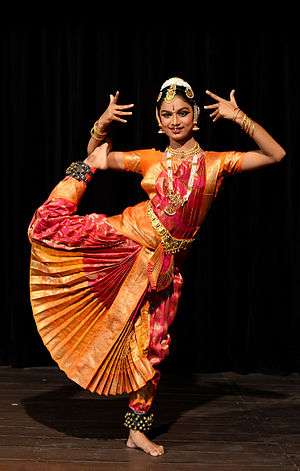 A Bharatanatyam dancer | |
| Genre | Indian classical dance |
|---|---|
| Origin | Tamil Nadu |
| Bharatanatyam | |
|---|---|
The Lord of the Dance | |
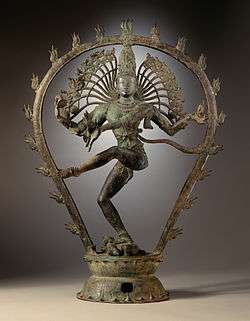 A 10th century Chola dynasty bronze sculpture of Shiva, the Lord of the Dance at the Los Angeles County Museum of Art | |
| Affiliation | Shiva Kanagasabainathar |
| Symbols | Agni |
| Texts | Anshumadbhed agama Uttarakamika agama |
Description of Bharatanatyam by 2nd century CE is noted in the ancient Tamil epic Silappatikaram, while temple sculptures of 6th to 9th century CE suggest it was a well refined performance art by the mid 1st millennium CE.[5][8] Bharatanatyam is the oldest classical dance tradition of India.[9] Theoretical foundations of the Indian classical dance laid out in Natya Shastra.[6] can be traced to various ancient art forms including Bharatanatyam.
Bharatanatyam style is noted for its fixed upper torso, bent legs and knees flexed (Aramandi) combined with spectacular footwork, and a sophisticated vocabulary of sign language based on gestures of hands, eyes and face muscles.[8] The dance is accompanied by music and a singer, and typically her guru is present as the Nattuvanar, director and conductor of the performance and art.[1] The dance has traditionally been a form of an interpretive narration of mythical legends and spiritual ideas from the Hindu texts.[4] The performance repertoire of Bharatanatyam, like other classical dances, includes nrita (pure dance), nritya (solo expressive dance) and natya (group dramatic dance).[4][10]
Bharatanatyam remained exclusive to Hindu temples through the 19th century.[8] It was banned by the colonial British government in 1910,[11] but the Indian community protested against the ban and expanded it outside the temples in the 20th century.[8][11][12] Modern stage productions of Bharatanatyam has been spread out and popular throughout India that has been done in different ways and have incorporated technical performances, pure dance based on non-religious ideas and fusion themes.[5][8]
Etymology
Originally known as Sadiraattam or Dashiattam (Tamil: சதிராட்டம்), the Indian classical dance form Bharatanatyam owes its current name, to E Krishna Iyer and Rukmini Devi Arundale, who were instrumental in modifying mainly the Pandanallur style of dancing bringing it to global attention, removing the sringaar (erotic) elements from the dance, which were the legacy of its Devadasi association in the past. The word Bharata is a mnemonic, consisting of "bha"–"ra"–"ta".[8] According to this belief, bha stands for bhava (feelings, emotions), ra stands for raga (melody, framework for musical notes), and ta stands for tala (rhythm).[8][13][14] The term Natya is a Sanskrit word for "dance". The compound word Bharatanatyam thus connotes a dance that harmoniously expresses bhava, raga, tala.[13]
History
The theoretical foundations of Bharatanatyam are found in Natya Shastra, the ancient Hindu text of performance arts.[5][16][17]
Natya Shastra is attributed to the ancient scholar Bharata Muni, and its first complete compilation is dated to between 200 BCE and 200 CE,[18][19] but estimates vary between 500 BCE and 500 CE.[20] The most studied version of the Natya Shastra text consists of about 6000 verses structured into 36 chapters.[18][21] The text, states Natalia Lidova, describes the theory of Tāṇḍava dance (Shiva), the theory of rasa, of bhāva, expression, gestures, acting techniques, basic steps, standing postures—all of which are part of Indian classical dances.[18][22] Dance and performance arts, states this ancient text,[23] are a form of expression of spiritual ideas, virtues and the essence of scriptures.[24]
More direct historical references to Bharatnatyam is found in the Tamil epics Silappatikaram (c. 2nd century CE[25]) and Manimegalai (c. 6th century).[5][8] The ancient text Silappatikaram, includes a story of a dancing girl named Madhavi; it describes the dance training regimen called Arangatrau Kathai of Madhavi in verses 113 through 159.[25] The carvings in Kanchipuram's Shiva temple that have been dated to 6th to 9th century CE suggest Bharatanatyam was a well developed performance art by about the mid 1st millennium CE.[5][8][26]
A famous example of illustrative sculpture is in the southern gateway of the Chidambaram temple (≈12th century) dedicated to the Hindu god Shiva, where 108 poses of the Bharatnatyam, that are also described as karanas in the Natya Shastra, are carved in stone.[28][29]
Many of the ancient Shiva sculptures in Hindu temples are the same as the Bharatanatyam dance poses. For example, the Cave 1 of Badami cave temples, dated to 7th-century,[30] portrays the Tandava-dancing Shiva as Nataraja.[31][32][33] The image, 5 feet (1.5 m) tall, has 18 arms in a form that expresses the dance positions arranged in a geometric pattern.[33] The arms of Shiva express mudras (symbolic hand gestures),[34] that are found in Bharatanatyam.[5][35]
Devadasis, anti-dance movement, colonial ban and the decline
Some colonial Indologists and modern authors have argued that Bharatanatyam is a descendant of an ancient Devadasi (literally, servant girls of Deva temples) culture, suggesting a historical origin back to between 300 BCE and 300 CE.[36] Modern scholarship has questioned this theory for lack of any direct textual or archeological evidence.[37][38] Historic sculpture and texts do describe and project dancing girls, as well as temple quarters dedicated to women, but they do not state them to be courtesans and prostitutes as alleged by early colonial Indologists.[36] According to Davesh Soneji, a critical examination of evidence suggests that courtesan dancing is a phenomenon of the modern era, beginning in the late 16th or the 17th century of the Nayaka period of Tamil Nadu.[36] According to James Lochtefeld, Bharatanatyam remained exclusive to Hindu temples through the 19th century, only in the 20th century appearing on stage outside the temples.[8] Further, the Maratha rulers of Tanjore patronized and contributed towards Bharatanatyam.[39]
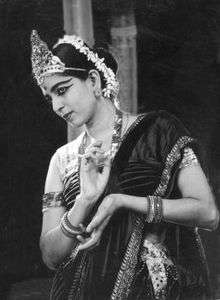
With the arrival of the East India Company in the 18th century, and British colonial rule in the 19th, many classical Indian dance forms were ridiculed and discouraged, and these performance arts declined.[40] Christian missionaries and British officials presented "nautch girls" of north India (Kathak) and "devadasis" of south India (Bharatanatyam) as evidence of "harlots, debased erotic culture, slavery to idols and priests" tradition, and Christian missionaries demanded that this must be stopped, launching the "anti-dance movement" in 1892.[41][42][43] The anti-dance camp accused the dance form as a front for prostitution, while revivalists questioned the constructed colonial histories.[37][38]
In 1910, the Madras Presidency of the British Empire altogether banned temple dancing, and with it the Bharatanatyam tradition within Hindu temples.[11]
Post-colonial revival
The 1910 ban triggered powerful protests against the stereotyping and dehumanization of temple dancers.[11] The Tamil people were concerned that a historic and rich dance tradition was being victimized under the excuse of social reform.[11][44] The classical art revivalists such as E. Krishna Iyer, a lawyer and someone who had learnt the Bharatanatyam dance, questioned the cultural discrimination and the assumed connection, asking why prostitution needs years of learning and training for performance arts such as the Bharatanatyam, and how can killing performance arts end any evils in a society?[45][46] Iyer was arrested and sentenced to prison on charges of nationalism, who while serving out his prison term persuaded his fellow political prisoners to support Bharatanatyam.[47]
While the British colonial government enforced laws to suppress Bharatanatyam and all Hindu temple dances, some from the West such as the American dancer Esther Sherman moved to India in 1930, learnt Indian classical dances, changed her name to Ragini Devi, and joined the movement to save and revive Bharatanatyam and other ancient dance arts.[48]
The Indian independence movement in early 20th century, already in progress, became a period of cultural ferment and initiated an effort by its people to reclaim their culture and rediscover history.[41][49][50] In this period of cultural and political turmoil, instead of Bharatnatyam becoming extinct, it expanded out of Hindu temples and was revived as a mainstream dance by Bharatnatyam artists such as Rukmini Devi Arundale, Balasaraswati and Yamini Krishnamurti[51][52] They championed and performed the Pandanallur (Kalakshetra) and Thanjavur styles of Bharatanatyam, respectively.[51]
In late 20th century, Tamil Hindu migrants reintroduced the Bharatanatyam traditions of temple dancing in British Tamil temples.[53]
Repertoire
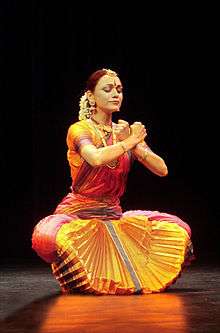
Bharata Natyam is traditionally a team performance art that consists of a solo dancer, accompanied by musicians and one or more singers. The theory behind the musical notes, vocal performance and the dance movement trace back to the ancient Natya Shastra, and many Sanskrit and Tamil texts such as the Abhinaya Darpana.[54][55]
The solo artist (ekaharya) in Bharatanatyam is dressed in a colorful Sari, adorned with jewelry who presents a dance synchronized with Indian classical music.[54] Her hand and facial gestures are codified sign language that recite a legend, spiritual ideas or a religious prayer derived from Hindu Vedic scriptures, the Mahabharata, the Ramayana, the Puranas and historic drama texts.[54][56] The dancer deploys turns or specific body movements to mark punctuations in the story or the entry of a different character in the play or legend being acted out through dance (Abhinaya). The footwork, body language, postures, musical notes, the tones of the vocalist, aesthetics and costumes integrate to express and communicate the underlying text.[54][57]
In modern adaptations, Bharata Natyam dance troupes may involve many dancers who play specific characters in a story, creatively choreographed to ease the interpretation and expand the experience by the audience.[58]
The repertoire of Bharatanatyam, like all major classical Indian dance forms, follows the three categories of performance in the Natya Shastra. These are Nritta (Nirutham), Nritya (Niruthiyam) and Natya (Natyam).[56]
Bharata Natyam is an art which consecrates the body (...)
the dancer, who dissolves her identity in rhythm and music, makes her body an instrument, at least for the duration of the dance, for the experience and expression of the spirit.
The traditional order of Bharata Natyam recital viz. alarippu, jatiswaram, varnam, padams, tillana and the shloka is the correct sequence in the practice of this art, which is an artistic Yoga, for revealing the spiritual through the corporeal.
- The Nritta performance is abstract, fast and rhythmic aspect of the dance.[61] The viewer is presented with pure movement in Bharatanatyam, wherein the emphasis is the beauty in motion, form, speed, range and pattern.[56] This part of the repertoire has no interpretative aspect, no telling of story. It is a technical performance, and aims to engage the senses (prakriti) of the audience.[62]
- The Nritya is slower and expressive aspect of the dance that attempts to communicate feelings, storyline particularly with spiritual themes in Hindu dance traditions.[61] In a nritya, the dance-acting expands to include silent expression of words through gestures and body motion set to musical notes. The actor articulates a legend or a spiritual message. This part of a Bharatanatyam repertoire is more than sensory enjoyment, it aims to engage the emotions and mind of the viewer.[56][62]
- The Natyam is a play, typically a team performance,[10] but can be acted out by a solo performer where the dancer uses certain standardized body movements to indicate a new character in the underlying story. A Natya incorporates the elements of a Nritya.[56]
Sequence
The traditional Bharatanatyam performance follows a seven-part order of presentation. This set is called margam.[59][63]
Alarippu
The presentation begins with a rhythmic invocation (vandana) called the Alaripu.[14] It is a pure dance, which combines a thank you and benediction for blessings from the gods and goddesses, the guru and the gathered performance team. It also serves as a preliminary warm up dance, without melody, to enable the dancer to loosen her body, journey away from distractions and towards single-minded focus.[59]
Jatiswaram
The next stage of the performance adds melody to the movement of Alarippu, and this is called Jatiswaram.[14][59] The dance remains a prelim technical performance (nritta), pure in form and without any expressed words. The drums set the beat, of any Carnatic music raga (melody). She performs a sequence (Korvai) to the rhythm of the beat, presenting to the audience the unity of music, rhythm and movements.[59]
Shabdam
The performance sequence then adds Shabdam (expressed words).[64] The solo dancer, the vocalist(s) and the musical team, in this stage of the production, present short compositions, with words and meaning, in a spectrum of moods.[65]
Varnam
The performance thereafter evolves into the Varnam stage.[64] This marks the arrival into the sanctum sanctorum core of the performance.[59] It is the longest section and the nritya. A traditional Varnam may be as long as 30–45 minutes or sometimes an hour. Varnam offer huge scope for improvisation and an experienced dancer can stretch the Varnam to a desirable length. The artist presents the play or the main composition, reveling in all her movements, silently communicating the text through codified gestures and footwork, harmoniously with the music, rhythmically punctuated. The dancer performs complicated moves, such as expressing a verse at two speeds.[66] Her hands and body tell a story, whether of love and longing, or of a battle between the good and the evil,[67] as the musicians envelop her with musical notes and tones that set the appropriate mood.[65]
Padam
The Padam is next.[64][68] This is the stage of reverence, of simplicity, of abhinaya (expression) of the solemn spiritual message or devotional religious prayer (bhakti). The music is lighter, the chant intimate, the dance emotional.[66][69] The choreography attempts to express rasa (emotional taste) and a mood, while the recital may include items such as a keertanam (expressing devotion), a javali (expressing divine love) or something else.[66][68]
Tillana
The performance sequence ends with a Tillana, the climax.[64] It closes out the nritya portion, the movements exit the temple of expressive dance, returning to the nritta style, where a series of pure movement and music are rhythmically performed. Therewith the performance ends.[59][66][note 1]
Shlokam or Mangalam
The seventh and final item in the sequence can be either a Shlokam or a Mangalam. The dancer calls for blessings on the people all around.[72]
The overall sequence of Bharatanatyam, states Balasaraswati, thus moves from "mere meter; then melody and meter; continuing with music, meaning and meter; its expansion in the centerpiece of the varnam; thereafter, music and meaning without meter; (...) a non-metrical song at the end. We see a most wonderful completeness and symmetry in this art".[73]
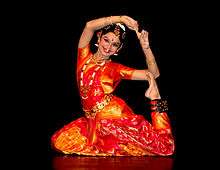
Attire
The attire of a Bharatanatyam dancer resembles a Tamil Hindu's bridal dress. It consists of a fitted, brilliantly colored Sari which is mainly of warm colors with mirrors on them. The Sari is made of a specially stitched pleated cloth which falls in front and opens like a hand fan when she flexes her knees or performs footwork. The Sari is worn in a special way, wrapped upwards along the back and tightly to the body contour, past one shoulder, with its end held at the waist by a jeweled belt.[74]
The dancer is typically adorned with jewelry on her ear, nose, and neck that outlines her head or hair. Her face has conventional makeup, eyes lined and ringed by collyrium, which help viewers see her eye expressions.[75] Her hair is tied up in the traditional way, often braided in with fragrant flowers (veni or gajra). She wears one or more leather anklets (ghungroos).[76][77]
The outlines of the dancer's fingers and feet may be partially colored red with kumkum powder or alta, a costume tradition that helps the audience more easily view her hand and foot gestures.[78]
Vocal Aspects and Musical Instruments
The accompanying music to Bharatanatyam is in the Carnatic style of South India, as is the recitation and chanting.[79] The vocalist is called the nattuvanar, typically also the conductor of the entire performance, who may be the guru of the dancer and may also be playing cymbals or one of the musical instruments.[70][80] The recited verses and text in Bharatanatyam are in Tamil, Telugu, Kannada and Sanskrit.[81]
The instruments used include the mridangam (double-sided drum), nadaswaram (long type of oboe made from a black wood), nattuvangam (cymbals), the flute, violin and veena.[70][75]
Symbolism
Bharatanatyam, like all classical dances of India, is steeped in symbolism, both in its abhinaya (acting) and its goals. The roots of abhinaya appear in the Natyashastra text, which defines drama in verse 6.10 as something that aesthetically arouses joy in the spectator, through the medium of actor's art of communication, that helps connect and transport the individual into a sensual inner state of being.[82] A performance art, asserts Natyashastra, connects the artists and the audience through abhinaya (literally, "carrying to the spectators"), that is applying body-speech-mind and scene, wherein the actors communicate to the audience, through song and music.[82] Drama in this ancient Sanskrit text, thus is an art that engages every aspect of life to glorify and give a state of joyful consciousness.[83]
The communication through symbols is in the form of expressive gestures and pantomime set to music. The gestures and facial expressions convey the ras (sentiment, emotional taste) and bhava (mood) of the underlying story.[84] In the Hindu texts on dance, the dancer successfully expresses the spiritual ideas by paying attention to four aspects of a performance: Angika (gestures and body language), Vachika (song, recitation, music and rhythm), Aharya (stage setting, costume, make up, jewelry), and Sattvika (artist's mental disposition and emotional connection with the story and audience, wherein the artist's inner and outer state resonates).[84] Abhinaya draws out the bhava (mood, psychological states).[84]
The gestures used in Bharatanatyam are called Hasta (or mudras). These symbols are of three types: asamyuta hastas (single hand gestures), samyuta hastas (two hand gestures) and nrtta hastas (dance hand gestures).[85] Like words in a glossary, these gestures are presented in the nritta as a list or embellishment to a prelim performance. In nritya stage of Bharatanatyam, these symbols set in a certain sequence become sentences with meaning, with emotions expressed through facial expressions and other aspects of abhinaya.[85]
Bharatanatyam contains at least 20 asanas found in modern yoga, including Dhanurasana (the bow, a back-arch); Chakrasana (the wheel, a standing back-arch); Vrikshasana (the tree, a standing pose); and Natarajasana, the pose of dancing Shiva.[86] 108 karanas of classical temple dance are represented in temple statuary; they depict the devadasi temple dancers who made use of yoga asanas in their dancing.[87] Bharatanatyam is also considered a form of Bhakti Yoga.[87] However, Natarajasana is not found in any medieval hatha yoga text; it was among the many asanas introduced into modern yoga by Krishnamacharya in the early 20th century.[88]
Modern revival: schools and training centers
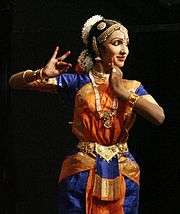
Bharatanatyam rapidly expanded after India gained freedom from the British rule in 1947. It is now the most popular classical Indian dance style in India, enjoys high degree of support in expatriate Indian communities, and is considered to be synonymous with Indian dance by many foreigners unaware of the diversity of dances and performance arts in Indian culture.[89] In the second half of the 20th century, Bharatanatyam has been to Indian dance tradition what ballet has been in the West.[89]
When the British tried to attempt to banish Bharatanatyam traditions, it went on and revived by moving outside the Hindu temple and religious ideas. However, post-independence, with rising interest in its history, the ancient traditions, the invocation rituals and the spiritual expressive part of the dance has returned.[89] Many innovations and developments in modern Bharatanatyam, states Anne-Marie Geston, are of a quasi-religious type.[89] Major cities in India now have numerous schools that offer lessons in Bharatanatyam, and these cities host hundreds of shows every year.[90][91]
Outside India, Bharatanatyam is a sought after and studied dance, states Meduri, in academic institutes in the United States, Europe, Canada, Australia, Sri Lanka, Malaysia and Singapore.[92] For expat Indian and Tamil communities in many countries, it is a source and means for social life and community bonding.[93] Contemporary Bharatanatyam choreographies include both male and female dancers.[28]
In 2020, an estimated 10,000 dancers got together in Chennai, India, to break the world record for the largest Bharatanatyam performance.[94] The previous record of 7,190 dancers was set in Chidambaram in 2019.[95]
Gallery
In cinema
- Senthamarai (Tamil, 1962)
- Thillana Mohanambal (Tamil, 1968)
- Paattum Bharathamum (Tamil, 1975)
- Salangai Oli (Tamil, 1983)
- Sagara Sangamam (Telugu, 1983)
- Mayuri (Telugu, 1985)
- Manichitrathazhu (Malayalam, 1993)
- Sringaram (Tamil, 2007)
- Kamaladalam(Malayalam, 1992)
Notes
- After the Tillana, the dancer may continue on to the seventh part, called Shloka.[70] It is a reverential greeting, a thank you or a prayer to one or more gods, goddesses or to one's teacher. This is a post-performance, where a Sanskrit verse (Shloka) is danced out in a form of nritya. An example Shloka:[71] "The Guru (teacher) is the Brahma, the Guru is the Vishnu, the Guru is the Maheshvara (Shiva). The Guru is the pathway to Supreme Brahman (supreme soul), to you the auspicious, I reverentially bow." Original: गुरुर्ब्रह्मा गुरुर्विष्णुर्गुरुर्देवो महेश्वरः । गुरुरेव परं ब्रह्म तस्मै श्रीगुरवे नमः ।।
References
- Bharata-natyam Encyclopædia Britannica. 2007
- Williams 2004, pp. 83-84, the other major classical Indian dances are: Kathak, Kuchipudi, Odissi, Kathakali, Danushka, Mohiniyattam, Manipuri and Sattriya.
- Banerjee, tProjesh (1983). Indian Ballet Dancing. New Jersey: Abhinav Publications. p. 43.
- Peter J. Claus; Sarah Diamond; Margaret Ann Mills (2003). South Asian Folklore: An Encyclopedia. Routledge. p. 136. ISBN 978-0-415-93919-5.
- Khokar, Mohan (1984). Traditions of Indian Classical Dance. India: Clarion Books. pp. 73–76.
- Richard Schechner (2010). Between Theater and Anthropology. University of Pennsylvania Press. pp. 65–66. ISBN 978-0-8122-0092-8.
- T Balasaraswati (1976), Bharata Natyam, NCPA Quarterly Journal, Volume 4, Issue 4, pages 1-8
- James G. Lochtefeld (2002). The Illustrated Encyclopedia of Hinduism: A-M. The Rosen Publishing Group. pp. 103–104. ISBN 978-0-8239-3179-8.
- Richard Schechner (2010). Between Theater and Anthropology. University of Pennsylvania Press. p. 65. ISBN 978-0812279290.
- Kavitha Jayakrishnan (2011), Dancing Architecture: the parallel evolution of Bharatanātyam and South Indian Architecture, MA Thesis, Awarded by University of Waterloo, Canada, page 25
- Pallabi Chakravorty; Nilanjana Gupta (2012). Dance Matters: Performing India on Local and Global Stages. Routledge. p. 30. ISBN 978-1-136-51612-2.
- Janet O'Shea (2007). At Home in the World: Bharata Natyam on the Global Stage. Wesleyan University Press. pp. 26–38, 55–57, 83–87. ISBN 978-0-8195-6837-3.
- Anjani Arunkumar (1989), Compositions for Bharatanāṭyam: A Soulful Worship the Divine, Bharatiya Vidya Bhavan, pp. xxi–xxii
- Brenda P McCutchen (2006). Teaching Dance as Art in. Human Kinetics. pp. 450–452. ISBN 978-0-7360-5188-0.
- James G. Lochtefeld (2002). The Illustrated Encyclopedia of Hinduism: A-M. The Rosen Publishing Group. pp. 126–127. ISBN 978-0-8239-3179-8.
- Eugenio Barba; Nicola Savarese (2011). A Dictionary of Theatre Anthropology: The Secret Art of the Performer. Routledge. p. 208. ISBN 978-1-135-17634-1.
- Peter Fletcher; Laurence Picken (2004). World Musics in Context: A Comprehensive Survey of the World's Major Musical Cultures. Oxford University Press. p. 262. ISBN 978-0-19-517507-3.
- Natalia Lidova 2014.
- Tarla Mehta 1995, pp. xxiv, 19–20.
- Wallace Dace 1963, p. 249.
- Emmie Te Nijenhuis 1974, pp. 1–25.
- Kapila Vatsyayan 2001.
- Guy L. Beck (2012). Sonic Liturgy: Ritual and Music in Hindu Tradition. University of South Carolina Press. pp. 138–139. ISBN 978-1-61117-108-2.
Quote: "A summation of the signal importance of the Natyasastra for Hindu religion and culture has been provided by Susan Schwartz, "In short, the Natyasastra is an exhaustive encyclopedic dissertation of the arts, with an emphasis on performing arts as its central feature. It is also full of invocations to deities, acknowledging the divine origins of the arts and the central role of performance arts in achieving divine goals (...)".
- Coormaraswamy and Duggirala (1917). "The Mirror of Gesture". Harvard University Press. p. 4.; Also see chapter 36
- Ragini Devi 1990, p. 47.
- Kilger, George (1993). Bharata Natyam in Cultural Perspective. New Delhi: Manohar American Institute of Indian Studies. p. 2.
- Allen G. Noble; Ashok K. Dutt (1982). India: Cultural Patterns and Processes. Westview Press. p. 160. ISBN 978-0-86531-237-1.
- Constance Jones; James D. Ryan (2006). Encyclopedia of Hinduism. Infobase Publishing. pp. 79, 107. ISBN 978-0-8160-7564-5.
- Vidya Dehejia (2013). Art of the Imperial Cholas. Columbia University Press. p. 101. ISBN 978-0-231-51524-5.
- JC Harle (1972), Aspects of Indian Art, BRILL Academic, ISBN 978-90-04-03625-3, page 68
- Michell 2014, p. 37–38.
- Fergusson 1880, p. 414.
- Alice Boner (1990), Principles of Composition in Hindu Sculpture: Cave Temple Period, Motilal Banarsidass, ISBN 978-81-208-0705-1, pages 89–95, 115–124, 174–184
- Fred Kleiner (2009), Gardner's Art through the Ages: Non-Western Perspectives, Wadsworth Publishing, ISBN 978-0-495-57367-8, page 21
- Kavitha Jayakrishnan (2011), Dancing Architecture: the parallel evolution of Bharatanātyam and South Indian Architecture, MA Thesis, Awarded by University of Waterloo, Canada, pages 21-27, 46
- Davesh Soneji (2011). Unfinished Gestures: Devadasis, Memory, and Modernity in South India. University of Chicago Press. pp. 30–31. ISBN 978-0-226-76811-3.
- Amrit Srinivasan (1983). "The Hindu Temple-dancer: Prostitute or Nun?". The Cambridge Journal of Anthropology. 8 (1): 73–99. JSTOR 23816342.
- Leslie C. Orr (2000). Donors, Devotees, and Daughters of God: Temple Women in Medieval Tamilnadu. Oxford University Press. pp. 5, 8–17. ISBN 978-0-19-535672-4.
- "Royal tribute to Thanjavur rulers". The New Indian Express. 2017.
- Leslie C. Orr (2000). Donors, Devotees, and Daughters of God: Temple Women in Medieval Tamilnadu. Oxford University Press. pp. 11–13. ISBN 978-0-19-535672-4.
- Mary Ellen Snodgrass (2016). The Encyclopedia of World Folk Dance. Rowman & Littlefield. pp. 165–168. ISBN 978-1-4422-5749-8.
- Nalini Ghuman (2014). Resonances of the Raj: India in the English Musical Imagination, 1897-1947. Oxford University Press. pp. 97 footnote 72. ISBN 978-0-19-931489-8.
- Margaret E. Walker (2016). India's Kathak Dance in Historical Perspective. Routledge. pp. 94–98. ISBN 978-1-317-11737-7.
- Kapila Vatsyayan 1974, p. 23.
- Amrit Srinivasan (1983). "The Hindu Temple-dancer: Prostitute or Nun?". The Cambridge Journal of Anthropology. 8 (1): 79–80. JSTOR 23816342.
- Meduri, Avanthi (1988). "Bharatha Natyam-What Are You?". Asian Theatre Journal. University of Hawaii Press. 5 (1): 5–7. doi:10.2307/1124019. JSTOR 1124019.
- Janet O'Shea (2007). At Home in the World: Bharata Natyam on the Global Stage. Wesleyan University Press. pp. 35–36. ISBN 978-0-8195-6837-3.
- Janet O'Shea (2007). At Home in the World: Bharata Natyam on the Global Stage. Wesleyan University Press. p. 7. ISBN 978-0-8195-6837-3.
- Margaret E. Walker (2016). India's Kathak Dance in Historical Perspective. Routledge. pp. 99–102. ISBN 978-1-317-11737-7.
- Ester Gallo (2016). Migration and Religion in Europe: Comparative Perspectives on South Asian Experiences. Routledge. p. 32. ISBN 978-1-317-09637-5.
- Paromitra Kar (2013). Adam M. Pine and Olaf Kuhlke (ed.). Geographies of Dance: Body, Movement, and Corporeal Negotiations. Lexington. pp. 5–6. ISBN 978-0-7391-7185-1.
- Janet O'Shea (2007). At Home in the World: Bharata Natyam on the Global Stage. Wesleyan University Press. pp. 82–85. ISBN 978-0-8195-6837-3.
- Ann David (2007), Religious Dogma or Political Agenda? Bharatanatyam and its Reemergence in British Tamil Temples, Journal for the Anthropological Study of Human Movement, Volume 14, Number 4, Fall 2007, University of Illinois Press, Archive
- Janet O'Shea (2007). At Home in the World: Bharata Natyam on the Global Stage. Wesleyan University Press. pp. 1–3, 26, 85–86. ISBN 978-0-8195-6837-3.
- Meduri, Avanthi (1988). "Bharatha Natyam-What Are You?". Asian Theatre Journal. University of Hawaii Press. 5 (1): 2–3. doi:10.2307/1124019. JSTOR 1124019.
- Meduri, Avanthi (1988). "Bharatha Natyam-What Are You?". Asian Theatre Journal. University of Hawaii Press. 5 (1): 3–4. doi:10.2307/1124019. JSTOR 1124019.
- Meduri, Avanthi (1988). "Bharatha Natyam-What Are You?". Asian Theatre Journal. University of Hawaii Press. 5 (1): 1–22. doi:10.2307/1124019. JSTOR 1124019.
- Katrak, Ketu H. (2004). "Cultural Translation of Bharata Natyam into Contemporary Indian Dance. Second-generation South Asian Americans and cultural politics in diasporic locations". South Asian Popular Culture. 2 (2): 79–102. doi:10.1080/1474668042000275699.
- T Balasaraswati (1976), Bharata Natyam, NCPA Quarterly Journal, Volume 4, Issue 4, page 3
- Meduri, Avanthi (1988). "Bharatha Natyam-What Are You?". Asian Theatre Journal. University of Hawaii Press. 5 (1): 7–8. doi:10.2307/1124019. JSTOR 1124019.
- Ellen Koskoff (2008). The Concise Garland Encyclopedia of World Music: The Middle East, South Asia, East Asia, Southeast Asia. Routledge. p. 955. ISBN 978-0-415-99404-0.
- Janet Descutner (2010). Asian Dance. Infobase. pp. 45–46. ISBN 978-1-4381-3078-1.
- Ann Cooper Albright; David Gere (2003). Taken by Surprise: A Dance Improvisation Reader. Wesleyan University Press. p. 143. ISBN 978-0-8195-6648-5.
- Kapila Vatsyayan (1997). The Square and the Circle of the Indian Arts. Abhinav Publications. p. 81. ISBN 978-81-7017-362-5.
- T Balasaraswati (1976), Bharata Natyam, NCPA Quarterly Journal, Volume 4, Issue 4, pages 3-5
- Bharatnatyam Dance, Centre for Cultural Resources and Training, Government of India
- Bajaj, Tanvi; Vohra, Swasti Shrimali (2015). Performing Arts and Therapeutic Implications. Routledge. p. 127. ISBN 978-1-317-32572-7.
- Ann Cooper Albright; David Gere (2003). Taken by Surprise: A Dance Improvisation Reader. Wesleyan University Press. pp. 141–147. ISBN 978-0-8195-6648-5.
- T Balasaraswati (1976), Bharata Natyam, NCPA Quarterly Journal, Volume 4, Issue 4, pages 3, 5-6
- Aakriti Sinha (2006). Let's Know Dances of India. Star. pp. 10–11. ISBN 978-81-7650-097-5.
- Swami Paramatmananda Puri; Amritanandamayi Devi (2015). Dust Of Her Feet. Sterling. p. 82. ISBN 978-1-68037-296-0.
- A Short Introduction to Bharatanatyam. Darbar Festival 2018 | An Evening of Bharatanatyam. Sadler's Wells. 24 November 2018.
- T Balasaraswati (1976), Bharata Natyam, NCPA Quarterly Journal, Volume 4, Issue 4, page 4
- Anjani Arunkumar (1989). Compositions for Bharatanāṭyam: A Soulful Worship of the Divine. Bharatiya Vidya Bhavan. pp. xxi–xxii.
- P. K. Ravindranath (1980). Bhavaṁ, ragaṁ, talam, natyaṁ: a hand-book of Indian dance. Savita Damodaran Arengetra Samiti. p. 75.
- Gurcharan Singh Randhawa; Amitabha Mukhopadhyay (1986). Floriculture in India. Allied Publishers. pp. 607–608. ISBN 978-81-7023-494-4.
- Swarajya Prakash Gupta; Krishna Lal; Mahua Bhattacharyya (2002). Cultural tourism in India: museums, monuments & arts. Indraprastha Museum of Art and Archaeology. p. 198. ISBN 978-81-246-0215-7.
- Maratt Mythili Anoop; Varun Gulati (2016). Scripting Dance in Contemporary India. Lexington Books. p. 96. ISBN 978-1-4985-0552-9.
- Siyuan Liu (2016). Routledge Handbook of Asian Theatre. Routledge. p. 132. ISBN 978-1-317-27886-3.
- TM Krishna (2013). A Southern Music. HarperCollins Publishers. pp. 147–148. ISBN 978-93-5029-822-0.
- Rosenblatt Louis; Sanford B. Steever (2015). The Dravidian Languages. Routledge. p. 2. ISBN 978-1-136-91164-4.
- Tarla Mehta 1995, p. 3.
- Tarla Mehta 1995, p. 5.
- Tanvi Bajaj; Swasti Shrimali Vohra (2015). Performing Arts and Therapeutic Implications. Routledge. pp. 82–84. ISBN 978-1-317-32572-7.
- Tanvi Bajaj; Swasti Shrimali Vohra (2015). Performing Arts and Therapeutic Implications. Routledge. pp. 85–87. ISBN 978-1-317-32572-7.
- Bhavanani, Ananda Balayogi; Bhavanani, Devasena (2001). "BHARATANATYAM AND YOGA". Archived from the original on 23 October 2006.
He also points out that these [Bharatanatyam dance] stances are very similar to Yoga Asanas, and in the Gopuram walls at Chidambaram, at least twenty different classical Yoga Asanas are depicted by the dancers, including Dhanurasana, Chakrasana, Vrikshasana, Natarajasana, Trivikramasana, Ananda Tandavasana, Padmasana, Siddhasana, Kaka Asana, Vrishchikasana and others.
- Rea, Shiva (28 August 2007). "The Divine Dance". Yoga Journal. Missing or empty
|url=(help) - Goldberg, Elliott (2016). The Path of Modern Yoga : the history of an embodied spiritual practice. Rochester, Vermont: Inner Traditions. pp. 223, 395–398. ISBN 978-1-62055-567-5. OCLC 926062252.
- Anne-Marie Gaston (1992). Julia Leslie (ed.). Roles and Rituals for Hindu Women. Motilal Banarsidass. pp. 149–150, 170–171. ISBN 978-81-208-1036-5.
- Anne-Marie Gaston (1992). Julia Leslie (ed.). Roles and Rituals for Hindu Women. Motilal Banarsidass. pp. 150–152. ISBN 978-81-208-1036-5.
- Ester Gallo (2016). Migration and Religion in Europe: Comparative Perspectives on South Asian Experiences. Routledge. pp. 32–33. ISBN 978-1-317-09637-5.
- Meduri, Avanthi (2004). "Bharatanatyam as a Global Dance: Some Issues in Research, Teaching, and Practice" (PDF). Dance Research Journal. 36 (2): 11–29. doi:10.2307/20444589. JSTOR 20444589.
- O'Shea, Janet (2003). "At Home in the World? The Bharatanatyam Dancer As Transnational Interpreter" (PDF). TDR. MIT Press. 47 (1): 176–186. doi:10.1162/105420403321250071.
- "Thousands of dancers mesmerize in world record attempt for largest Bharatanatyam performance" (Video). MSN. 12 February 2020.
- "Over 7,000 Bharatanatyam dancers set a world record". Daily News (Source: The Hindu). 4 March 2019.
Bibliography
- Uttara Asha Coorlawala, ed. Re-presenting Indian Dance. Dance Research Journal. Congress on Research in Dance 36/2. Winter 2004. ISSN 0149-7677
- Wallace Dace (1963). "The Concept of "Rasa" in Sanskrit Dramatic Theory". Educational Theatre Journal. 15 (3): 249–254. doi:10.2307/3204783. JSTOR 3204783.CS1 maint: ref=harv (link)
- Ragini Devi (1990). Dance Dialects of India. Motilal Banarsidass. ISBN 978-81-208-0674-0.CS1 maint: ref=harv (link)
- Fergusson, James (1880). The Caves Temples of India. W. H. Allen. Retrieved 2 April 2016.CS1 maint: ref=harv (link)
- Douglas M. Knight, Jr. Balasaraswati: Her Art and Life. Wesleyan University Press. Middletown, CT, 2010. ISBN 978-0-8195-6906-6
- Sunil Kothari, Bharata Natyam, Marg Publications, Mumbai: 1997.
- Natalia Lidova (2014). "Natyashastra". Oxford University Press. doi:10.1093/obo/9780195399318-0071. Cite journal requires
|journal=(help)CS1 maint: ref=harv (link) - Natalia Lidova (1994). Drama and Ritual of Early Hinduism. Motilal Banarsidass. ISBN 978-81-208-1234-5.
- Tarla Mehta (1995). Sanskrit Play Production in Ancient India. Motilal Banarsidass. ISBN 978-81-208-1057-0.CS1 maint: ref=harv (link)
- Michell, George l (15 October 2014). Temple Architecture and Art of the Early Chalukyas: Badami, Mahakuta, Aihole, Pattadakal. Niyogi Books. ISBN 978-93-83098-33-0.CS1 maint: ref=harv (link)
- Narayanan Chittoor Namboodiripad, "Revealing the Art of Natyasastra." ISBN 9788121512183
- Srividya Natarajan Another Stage in the Life of the Nation: Sadir, Bharatanatyam, Feminist Theory. Unpublished Ph.D Thesis, Dept of English, University of Hyderabad, 1997.
- Emmie Te Nijenhuis (1974). Indian Music: History and Structure. BRILL Academic. ISBN 90-04-03978-3.CS1 maint: ref=harv (link)
- Sukanya Rahman. Dancing in the Family. Rupa and Co. New Delhi: 2004. ISBN 81-291-0594-2
- Vijaya Rao, (1987), Abbild des Göttlichen. Bharata Natyam. Der klassische Indische Tanz. Freiburg (Germany)
- Kapila Vatsyayan (2001). Bharata, the Nāṭyaśāstra. Sahitya Akademi. ISBN 978-81-260-1220-6.CS1 maint: ref=harv (link)
- Kapila Vatsyayan (1977). Classical Indian dance in literature and the arts. Sangeet Natak Akademi. OCLC 233639306., Table of Contents
- Kapila Vatsyayan (1974), Indian classical dance, Sangeet Natak Akademi, OCLC 2238067
- Kapila Vatsyayan (2008). Aesthetic theories and forms in Indian tradition. Munshiram Manoharlal. ISBN 978-8187586357. OCLC 286469807.
- Kapila Vatsyayan. Dance In Indian Painting. Abhinav Publications. ISBN 978-81-7017-153-9.
- Williams, Drid (2004). "In the Shadow of Hollywood Orientalism: Authentic East Indian Dancing" (PDF). Visual Anthropology. Routledge. 17 (1): 69–98. doi:10.1080/08949460490274013.CS1 maint: ref=harv (link)
External links
| Wikimedia Commons has media related to Bharatanatyam. |
| Wikiquote has quotations related to: Bharatanatyam |
.jpg)
_(14146091479).jpg)
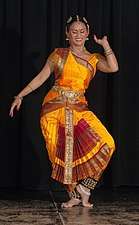

.jpg)

